6 Easy Houseplants That Are Low-Maintenance Wonders, According to Plant Pros
Looking to liven up your home with houseplants, but worried that you don’t have enough of a green thumb to help them thrive? Don't fret! Although keeping houseplants alive can be intimidating, there are several easy-to-care-for plant varieties that will thrive in almost any environment, and they’ll even bounce back if you forget to water them every once in awhile. Plus, the green beauties are sure to invigorate your home with refreshing flair and even purify the air while they’re at it! Here, plant experts share their favorite easy houseplants and how to care for them.
Easy houseplants idea #1: Air plants
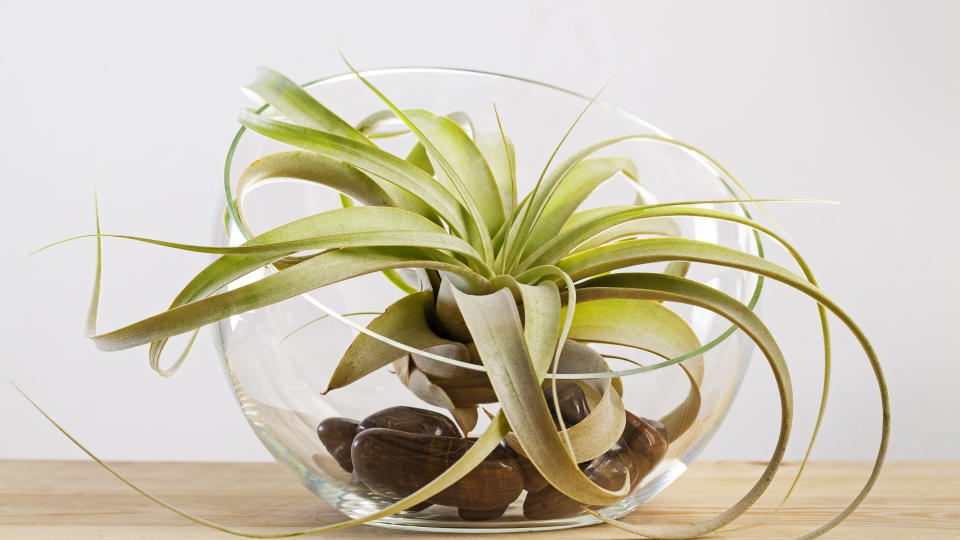
“Tillandsia, better known as air plants, are adorable, easy to care for and fit into any spot,” says Maria Colletti, author of Terrariums: Gardens Under Glass and Living Decor. Air plants are unique among houseplants because they don’t require soil to grow. Instead, they get their nutrients from the air (hence the name “air plants”). It’s for this reason that air plants are popular home decor options in places with indirect sunlight and little capacity for caretaking. While they do need some attention, air plants are hardy, flexible and able to grow with infrequent watering in low-light conditions. If you find yourself constantly juggling responsibilities, are often away from home or are generally forgetful, these might be the plants for you.
While air plants can simply be rested on a shelf, ledge or countertop as-is, you can give them an artful “home” by filling a vessel (like a low bowl) with pebbles or sand (the materials will absorb excess water, preventing plant rot). Then mist your air plant with water and set atop the sand or pebbles. Place the vessel in a spot that gets bright, indirect light and water your plant twice weekly by misting with water. Tip: Like peace lilies, air plants love humidity, so keeping them in a kitchen or bathroom window is ideal.
Related: Garden Pros: Attract Butterflies to Your Yard with These Easy-Care Flowers
Easy houseplants idea #2: Peace lilies
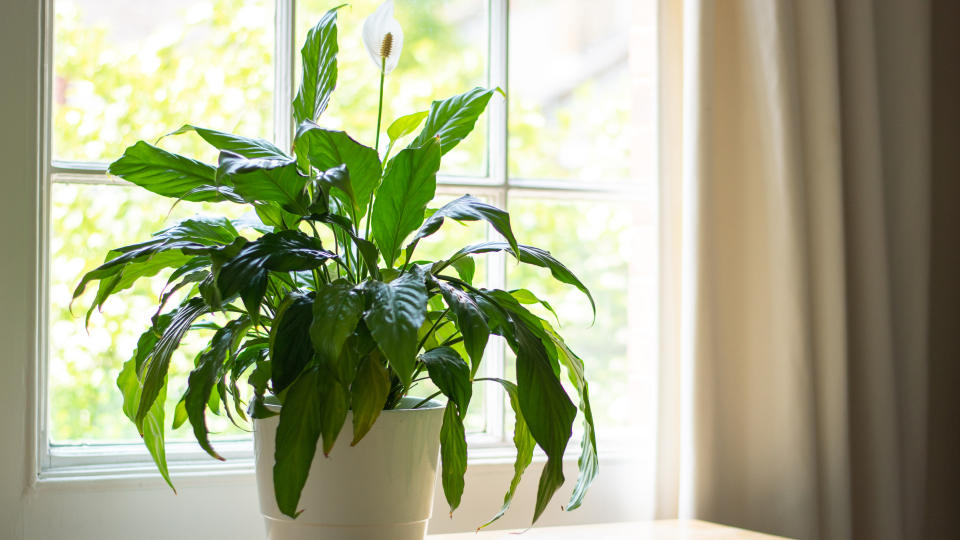
With its serenely sculptural blooms and lush green foliage, the low-maintenance peace lily creates a tranquil atmosphere that instantly calms—perfect for bringing a peaceful feeling to a hectic, high-traffic kitchen or a serene, spa-like vibe to a bathroom. What’s more? The plants will thrive in those areas thanks to the humidity in the air from boiling water on the stove and taking steamy showers.
“Peace lilies love moisture and tolerate very low light,” notes Tovah Martin, author of The Indestructible Houseplant. But the plant is susceptible to root rot, so she recommends placing a layer of pebbles or charcoal in the bottom of your plant pot before adding soil and your lily plant. The layer encourages proper drainage and helps the beautiful blooms last longer. Peace lilies thrive when watered around once a week and kept in spot that gets indirect light. Tip: If you worry about under watering a low-maintenance plant like a peace lily, look at the plant’s leaves for your watering cue. They droop dramatically when thirsty and perk back up soon after watering. Once you’ve observed this behavior a few times, it’ll be easy to tell when it’s watering time and when your peace lily is happy.
Related: How to Germinate Seeds Indoors: Gardening Pros Share Their Top Tricks for Success
Easy houseplants idea #3: Ferns
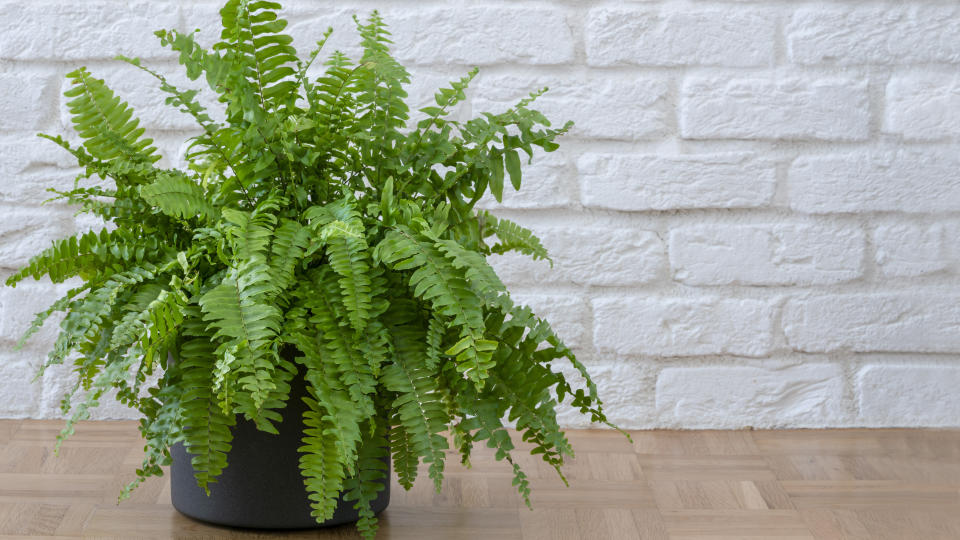
“Ferns naturally thrive in shaded areas of the forest, making them ideal for low-light dens or living rooms,” The Houseplant Guru Lisa Eldred Steinkopf, author of Grow in the Dark. All it takes is a little regular watering to keep this easy-care, lush green plant happy and growing. “A Boston fern develops a weeping habit that is gorgeous,” says Steinkopf. “It starts out more upright, but as it gets larger it begins to cascade.”
Worried about not watering your fern enough? Don’t fret! Steinkopf suggests nestling the roots of a fern plant into a glazed ceramic pot or plastic pot (their material helps trap moisture in the soil, unlike terra cotta which absorbs the liquid and allows it to evaporate) filled with moisture-retaining soil (available at garden centers). Then place the pot in a spot that gets morning sun (an east-facing window is best), and make sure your fern does not dry out completely.
Easy houseplants idea #4: Snake plants

If you don’t already have one in your home, you’ve probably at least seen a snake plant before — easy-going and perfect for small spaces, these elegant, spiky plants are a home and office decor staple. “In fact, snake plants have become one of the most collectible plants on the planet,” says Steinkopf. “There are so many different species and cultivars of snake plants, and everyone wants one of each!” The plants are drought-tolerant, extremely low-maintenance and grow sticking straight up, making them a “statement plant” unique among its houseplant counterparts.
Simply pick up a snake plant from the plant nursery and remove it from its plastic nursery pot, then nestle roots into a pot filled with soil. Optional: Top the soil with craft-store moss for a decorative touch that will also help the soil retain moisture. “Although this plant is touted as a low-light plant, be aware that it will merely survive in low light and prefers the brightest spot you have,” says Steinkopf. “A south or west window is perfect.”
Water them thoroughly when the soil is almost completely dry, not allowing their leaves to wrinkle. “If your leaves are puckered like fingers in a bathtub, it is a sign they are extremely dry,” she says. Tip: Snake plants appreciate a good cleaning, particularly if they live on a windowsill or any other dust-prone places, since snake plant leaves can’t perform the vital process of photosynthesis when covered in dust. Simply wipe them down once in a while with a damp cloth to remove any dirt or dust.
Related: Plant a Garden You Didn’t Think You Could Grow With These Simple Tips and Tricks
Easy houseplants idea #5: Spider plant
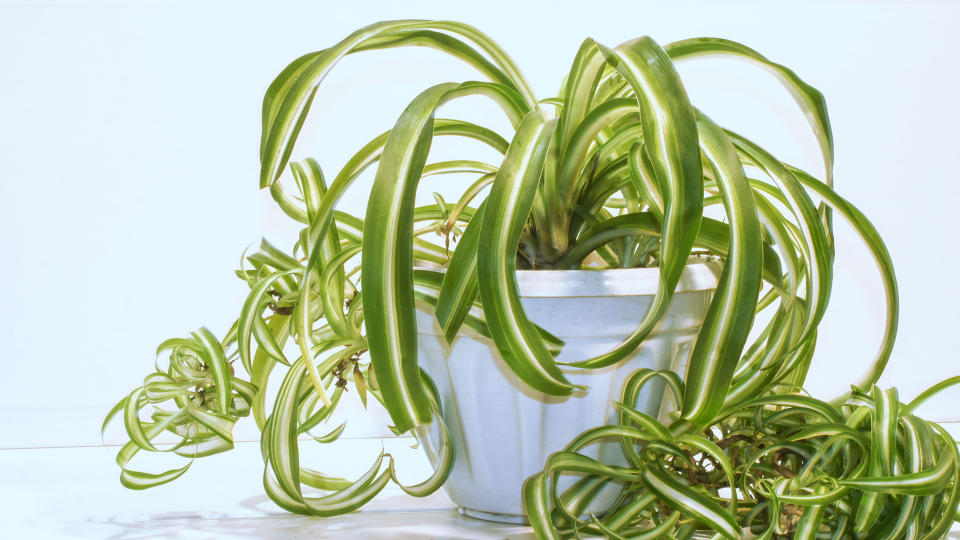
Although their insect namesake can make this plant sound intimidating, spider plants are a perfect, low-maintenance choice for an entry-level home gardener. “Spiky green spider plants get their name from their stolons that grow small, swinging baby spider plants,” explains Steinkopf. “They resemble baby spiders swinging from a web, thus the name.” These little baby plants can be plucked off and propagated in water or soil to make new spider plants.
To do: Pick up a spider plant from the plant nursery, remove it from its plastic plant pot and nestle roots in a pot filled with potting soil. Spider plants prefer bright light, or else their long leaves will stretch and become floppy, says Steinkopf. "Full sun though, such as in a south or direct west window may cause them to look pale and bleached out from the sun," she says. Allow soil to dry out between waterings. Tip: Spider plants are sensitive to soluble salts in potting soil and may develop brown tips on the leaves because of this, notes Steinkopf. To prevent this, she suggests flushing the soil often with water to rinse the potting medium and get rid of impurities.
Easy houseplants idea #6: Zanzibar gem or ZZ plants
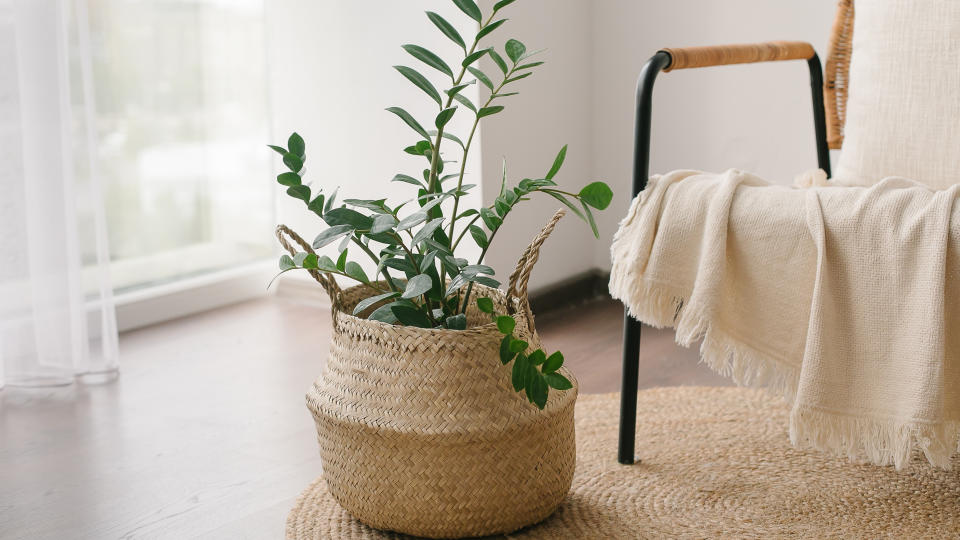
“Zanzibar gem or ‘ZZ’ plants add modern flair to any home,” says Steinkopf. “Their dark green, glossy foliage is like no other.” The Zanzibar gem is an amazingly diverse plant, able to take bright sun or a low light situation, she says. And because of its large fleshy roots, this plant doesn’t need to be watered as regularly as many other plants, making it very low maintenance.
Once you bring your Zanzibar gem plant home from the plant store or nursery, you might notice that its roots are circling the inside of its nursery pot and coming out of the drainage holes at the bottom. If this is the case, the plant needs to be potted in a larger pot, says Steinkopf. “Just choose a pot that is one size up, fill with potting soil, then nestle roots into soil. If your plant’s roots aren’t circling the inside of the pot it came in, simply nestle its roots into a soil-filled pot of the same size. Keep the plant in a spot that gets low to bright light; water when soil is dry. Tip: If your Zanzibar gem is in a low light situation, it will need even less water and can go longer between waterings.
Easy houseplant honorable mentions
These easygoing houseplants will also spruce up your home:
The monstera deliciosa’s big green leaves will fill a windowsill or empty living room corner.
Small succulents are low-maintenance and add texture to any design motif.
The fiddle-leaf fig, which has massive teardrop-shaped leaves, thrives in medium light.
Bonsai trees lend dimension and fun to the home.
Aloe vera plants are lovely — and come in handy when you have a sunburn.
Low-effort philodendrons, which can range from small potted varieties to massive shrub-like behemoths, are great for new plant parents.
The dark, distinctive green leaves of Calatheas make a statement.
The aptly named swiss cheese plant is a monstera variety with holes in its leaves.
The ficus, a mini tree of sorts, fits in small corners and nooks.
Solve the daily Crossword

